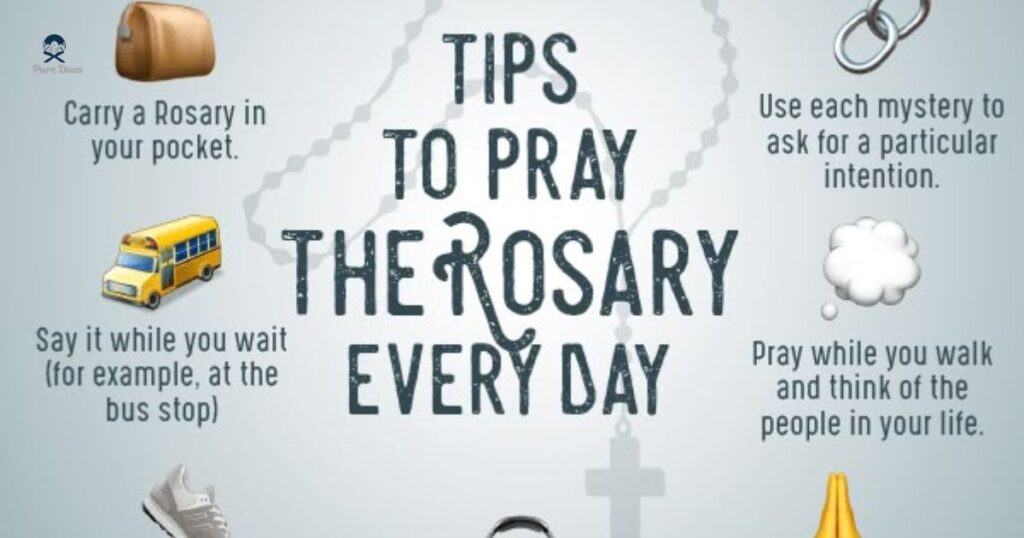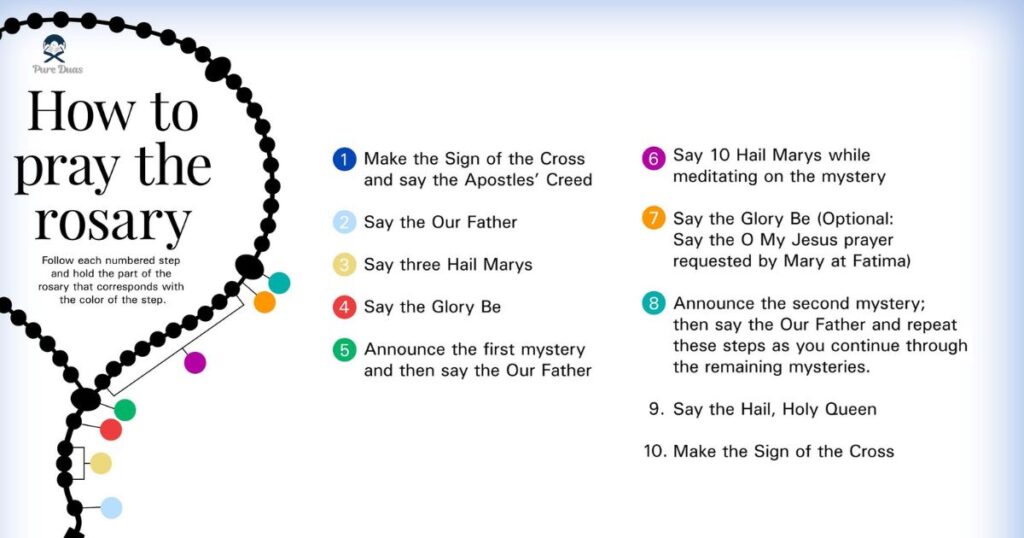Have you ever felt overwhelmed by life’s chaos and desperately needed peace? The Rosary might be exactly what you are searching for. This ancient Catholic prayer has transformed countless lives over centuries, bringing calm to troubled hearts and strength to weary souls. Whether you’re completely new to this powerful devotion or looking to deepen your existing practice, you’ll find everything you need right here.
This complete Rosary guide with litany walks you through every prayer, every mystery, and every step of this beautiful meditation. You will discover the rich history behind those sacred beads, understand why millions pray it daily, and learn practical ways to make the Rosary part of your routine. From the opening prayers to the optional litany, we are covering it all. No confusing jargon. No assumptions about prior knowledge. Just straightforward, helpful guidance to help you pray with confidence and devotion.
Ready to unlock the power of the Rosary? Let’s begin this spiritual journey together.
What Does “Rosary” Mean?
The word “rosary” comes from Latin, specifically from “rosarium.” It translates to rose garden or garland of roses.This is not just a random name. Roses have been associated with Our Lady for centuries. When we pray the Rosary, we’re essentially offering roses to Mary with each prayer we recite.
Each Hail Mary is like handing a single rose to the Blessed Virgin Mary. By the time you finish a complete Rosary, you have presented her with a stunning bouquet, a spiritual garland of roses crafted from your devotion.The symbolism runs deep. Roses represent purity, love, and beauty. Mary embodies all these qualities perfectly.
Where Does the Rosary Come From?

The Rosary prayer has fascinating roots that stretch back centuries. The version we know today took its final form around the Council of Trent in the mid-16th century.But prayer beads? They’re ancient. People across different religions have counted prayers on beads, stones, and knotted cords for thousands of years.
Catholic monasteries used to pray all 150 Psalms every single day. However, most laypeople couldn’t read or memorize all those psalms. They were illiterate and needed another way to join the monks in prayer.The solution? They prayed 150 Paternosters (Our Fathers) instead. Eventually, Hail Marys replaced the Our Fathers, and the structure we recognize today began taking shape. St. Dominic played a crucial role in developing and spreading this devotion.
The Battle of Lepanto sealed the Rosary’s reputation as a powerful prayer. On October 7, 1571, Christian forces faced the mighty Ottoman Empire’s navy. The odds? Terrible. The Holy League consisted mainly of farmers and poorly trained men going up against experienced warriors with superior ships.
Pope Pius V knew they needed divine intervention. He called on all Christians to pray the Rosary to Our Lady of Victory. After just four hours of battle, the Holy League achieved the impossible, they won decisively!This miraculous victory led to the establishment of the Feast of the Holy Rosary on October 7. The entire month of October became dedicated to the Rosary.
Why Pray the Rosary?
Our Lady herself has asked us. She has appeared in five different locations over the past century, Portugal, Japan, Rwanda, Argentina, and Nicaragua. In each appearance, sometimes with tears streaming down her face, she begged humanity to pray the Rosary daily. She’s specifically requested this prayer for the conversion of sinners and for turning the world back to God.
It is thoroughly Biblical. The Rosary is not some made-up tradition. Jesus Himself taught us the Our Father. The first half of the Hail Mary comes straight from Scripture, Luke 1:28 and Luke 1:42. Even the mysteries we meditate on are Biblical events from Christ’s life.
The repetition actually helps your mind focus. That rhythmic recitation of prayers calms mental chatter. Your mind settles down, making it easier to genuinely meditate on the mysteries of the Rosary.We are honoring our Heavenly Mother. The fourth commandment tells us to honor our mother and father. Mary is our Heavenly Mother, Jesus gave her to us from the cross. When we pray the Rosary, we’re showing her the respect and love she deserves.
Mary knew Jesus better than anyone. She carried Him, raised Him, watched Him grow. When we pray the Rosary with her, we’re seeing Christ through her eyes. She guides us toward a deeper understanding of her Son, helping us become more like Him.
The Rosary has proven power. Beyond the Battle of Lepanto victory, countless miracles and answered prayers are attributed to this devotion. Saints throughout history have testified to its effectiveness.St. Francis de Sales declared: “The greatest method of praying is to pray the Rosary.”
St. Padre Pio put it even more bluntly: “Some people are so foolish that they think they can go through life without the help of the Blessed Mother. Love the Madonna and pray the Rosary, for her Rosary is the weapon against the evils of the world today.”Pope John Paul II wrote an entire letter about the Rosary called “Rosarium Virginis Mariae.”
How Often Should I Pray the Rosary?
Daily Rosary practice is ideal. Mary has specifically asked for daily recitation during her apparitions.But let us be realistic. If you are just starting out, a full five-decade Rosary might feel overwhelming. Start with one decade each day. Just one. That’s ten Hail Marys plus a few other prayers, totally manageable.
Once that becomes comfortable and habitual, add another decade. Before you know it, you’ll be praying all five decades without it feeling like a burden.
Some devoted Catholics even pray the full Rosary,all 15 decades, every single day. That is the traditional practice that mirrors the 150 Psalms in the Bible.The key is consistency over perfection. Better to pray one decade faithfully every day than to pray five decades sporadically when you remember.
When Should I Pray the Rosary?

You can pray the Rosary literally anytime. But having a specific time helps build that habit.
After dinner with your family works wonderfully. Yes, it can get chaotic with kids. But God does not demand perfect silence. He appreciates the effort, wiggly toddlers and all. Family prayer time teaches children the importance of devotion and creates beautiful memories.Morning prayers set a peaceful tone for your entire day. Wake up 20 minutes earlier than usual. Grab your beads and a cup of coffee. Start your day in conversation with the Mother of God.
Before bed helps calm your mind for sleep. The rhythmic prayers naturally relax you.In the car during your commute works great, as long as it does not distract your driving.
Rosary walks combine meditation with gentle exercise. Walking outdoors while praying connects you with God’s creation in a special way.Before Mass prepares your heart for the Eucharist. Many churches actually pray the Rosary together as a community before Mass begins.
How to Pray the Rosary: A Step-by-Step Guide
This step-by-step guide will walk you through the entire Rosary from beginning to end.
Opening Prayers
These prayers prepare your heart and mind for meditation on Christ’s life.
Apostle’s Creed
Hold the crucifix on your Rosary beads and recite the Apostle’s Creed:
“I believe in God, the Father Almighty, Creator of Heaven and earth; and in Jesus Christ, His only Son Our Lord, Who was conceived by the Holy Spirit, born of the Virgin Mary, suffered under Pontius Pilate, was crucified, died, and was buried. He descended into Hell; the third day He rose again from the dead; He ascended into Heaven, and sitteth at the right hand of God, the Father almighty; from thence He shall come to judge the living and the dead. I believe in the Holy Spirit, the holy Catholic Church, the communion of saints, the forgiveness of sins, the resurrection of the body and life everlasting. Amen.”
Our Father
Move to the first large bead and pray to Our Father for the traditional intentions of the pope:”Our Father, Who art in heaven, Hallowed be Thy Name. Thy Kingdom come. Thy Will be done, on earth as it is in Heaven. Give us this day our daily bread. And forgive us our trespasses, as we forgive those who trespass against us. And lead us not into temptation, but deliver us from evil. Amen.”
Three Hail Mary’s
On the next three small beads, pray three Hail Mary’s for an increase in faith, hope, and charity:”Hail, Mary, full of grace, the Lord is with thee. Blessed art thou amongst women and blessed is the fruit of thy womb, Jesus. Holy Mary, Mother of God, pray for us sinners, now and at the hour of our death. Amen.”The first part comes directly from Angel Gabriel’s greeting to Mary and Elizabeth’s exclamation when Mary visited her.
Glory Be
After the three Hail Marys, pray the Glory Be. Notice there’s no bead for this prayer:”Glory be to the Father, and to the Son, and to the Holy Spirit. As it was in the beginning, it is now, and ever shall be, a world without end. Amen.”
Decades
Now we get to the main body of the Rosary. Each decade follows the same structure, but you meditate on a different mystery during each one.A standard Rosary has five decades. If you wanted to pray the full traditional Rosary with all 15 mysteries, you’d simply go around the beads three times.
Our Father
On each large bead, pray one Our Father.
Ten Hail Mary’s
On the ten small beads following each Our Father, pray ten Hail Marys. While reciting these, meditate on the mystery you’ve chosen for that decade.This is where real meditation happens. Let the repetitive prayers quiet your mind while you contemplate Christ’s life through Mary’s eyes.
Glory Be
After the tenth Hail Mary in each decade, pray the Glory Be again.
Fatima Prayer
This prayer is optional, but Our Lady of Fatima specifically requested we add it in the early 20th century:”O my Jesus, forgive us our sins, save us from the fires of hell, and lead all souls to heaven, especially those most in need of Thy mercy.”
Repeat this entire decade structure five times, focusing on five different mysteries.
Closing Prayers
Hail, Holy Queen
This traditional Marian prayer is the standard conclusion:
“Hail, Holy Queen, Mother of Mercy, our life, our sweetness and our hope. To thee do we cry, poor banished children of Eve. To thee do we send up our sighs, mourning and weeping in this valley of tears. Turn then, most gracious advocate, thine eyes of mercy toward us, and after this our exile shows unto us the blessed fruit of thy womb, Jesus. O clement, O loving, O sweet Virgin Mary.”V. Pray for us, O Holy Mother of God. R. That we may be made worthy of the promises of Christ.
Rosary Prayer (Optional)
V. Let us pray, R. O God, whose only begotten Son, by His life, death, and resurrection, has purchased for us the rewards of eternal salvation. Grant, we beseech Thee, that while meditating on these mysteries of the Rosary, that we may both imitate what they contain and obtain what they promise, through Christ our Lord. Amen.Most Sacred Heart of Jesus, have mercy on us. Immaculate Heart of Mary, pray for us.You can also add other prayers here: the St. Michael prayer, intercessory prayers to various saints, or any personal intentions.
The Rosary Litany
The Rosary Litany, also called the Litany of Loreto or Litany of the Blessed Virgin Mary, offers a beautiful optional closing to your Rosary. Pope Sixtus V approved it in 1587.This litany honors Mary through dozens of titles, each highlighting different aspects of her role and virtues. It follows a simple call-and-response pattern.
Here’s the complete litany:
Lord, have mercy on us. Christ, have mercy on us. Lord, have mercy on us. Christ, hear us. Christ, graciously hear us.God, the Father of heaven, have mercy on us. God, the Son, Redeemer of the world, has mercy on us. God, the Holy Spirit, has mercy on us. Holy Trinity, one God, have mercy on us. Holy Mary, pray for us. Holy Mother of God, pray for us. Holy Virgin of virgins, pray for us. Mother of Christ, pray for us. Mother of the Church, pray for us. Mother of Mercy, pray for us. Mother of divine grace, pray for us. Mother of hope, pray for us. Mother most pure, pray for us. Mother most chaste, pray for us. Mother inviolate, pray for us. Mother undefiled, pray for us. Mother most amiable, pray for us. Mother most admirable, pray for us. Mother of good counsel, pray for us. Mother of our Creator, pray for us. Mother of our Savior, pray for us.Virgin most prudent, pray for us. Virgin most venerable, pray for us. Virgin most renowned, pray for us. Virgin most powerful, pray for us. Virgin most merciful, pray for us. Virgin, most faithful, pray for us.
V. Lamb of God, who takest away the sins of the world. R. Spare us, O Lord. V. Lamb of God, who takest away the sins of the world. R. Graciously hear us O Lord. V. Lamb of God, who takest away the sins of the world. R. Have mercy on us.V. Pray for us, O Holy Mother of God. R. That we may be made worthy of the promises of Christ.The litany takes about five minutes to recite. It’s a wonderful way to honor Mary more fully and reflect on her many roles in salvation history.
Mysteries of the Rosary
The mysteries of the Rosary are specific events from Christ’s life that we meditate on while praying each decade. There are traditionally fifteen mysteries divided into three groups of five.Each day of the week has assigned mysteries, though you can adjust based on circumstances. For example, you might pray the Joyful Mysteries on Christmas regardless of the day, or the Sorrowful Mysteries throughout Lent.
Joyful Mysteries
These are traditionally prayed on Mondays and Thursdays. They focus on joy, anticipation, and the early life of Christ.=The Annunciation (Luke 1:28) , Angel Gabriel appeared to Mary, announcing she’d been chosen to bear the Son of God. Mary’s “yes” changed everything. Meditate on her trust and humility.
The Visitation (Luke 1:41-42) , Mary visited her cousin Elizabeth, who was pregnant with St. John the Baptist. Elizabeth’s baby leaped in her womb recognizing Christ. Reflect on Mary’s charity in helping her cousin.The Nativity (Luke 2:7) , Jesus was born in Bethlehem in a humble stable. The Creator of the universe entered His creation as a helpless baby. Consider the humility of this moment.
The Presentation (Luke 2:22-23) , Forty days after His birth, Mary and Joseph presented Jesus in the Temple according to Jewish law. Simeon prophesied that a sword would pierce Mary’s heart. Think about Mary’s obedience to God’s law.Finding in the Temple (Luke 2:46) , After losing Jesus for three days, Mary and Joseph found Him teaching in the Temple at age twelve. Contemplate the anxiety Mary felt and her relief at finding Him.
Sorrowful Mysteries
Prayed on Tuesdays and Fridays, these mysteries focus on Christ’s passion and suffering for our sins.
Agony in the Garden (Luke 22:44-45) , Jesus sweated blood in the Garden of Gethsemane, overwhelmed with grief for our sins and His coming torture. Reflect on the weight of sin and Christ’s willingness to bear it.
Scourging at the Pillar (John 19:1) , Roman soldiers brutally whipped Jesus until He was covered in bloody wounds. Meditate on the physical pain He endured for us.
Crowning with Thorns (Matthew 27:28-29) , Soldiers mocked Jesus by pressing a crown of thorns onto His head, calling Him “King of the Jews.” Consider how He accepted humiliation for our pride.
Carrying the Cross (John 19:17) , Jesus carried His heavy cross through Jerusalem to Golgotha, the Place of the Skull. Think about the burdens we carry and how Christ helps us bear them.
The Crucifixion (Luke 23:46) , Jesus was nailed to the cross and died after three hours of agony at 3pm on Good Friday. Contemplate the ultimate sacrifice—God dying for humanity’s redemption.
Glorious Mysteries
These are prayed on Wednesdays, Saturdays, and Sundays. They celebrate Christ’s triumph over death and Mary’s glory.The Resurrection (Mark 16:6) , Jesus rose from the dead on the third day, just as He promised. Death could not hold Him. Reflect on the hope this gives us.
The Ascension (Mark 16:19) , Forty days after His resurrection, Jesus ascended into Heaven before His disciples’ eyes. Meditate on Christ’s return to the Father and His promise to prepare a place for us.Descent of the Holy Spirit (Acts 2:4) , The Holy Spirit descended upon the Apostles at Pentecost, filling them with courage to spread the Gospel. Consider how the Spirit guides and strengthens us today.
The Assumption (Judith 15:9-10) , Mary was assumed into Heaven, body and soul, at the end of her earthly life. God would not let His mother’s body see corruption. Contemplate the honor God shows those who serve Him faithfully.The Coronation (Revelation 12:1) – Mary was crowned Queen of Heaven and Earth. Reflect on her role as our advocate and intercessor before her Son.
Different Ways to Pray the Rosary

Sometimes the daily Rosary becomes so routine that we go through the motions without real prayer happening. When that occurs, switch things up.Meditate on different Scripture passages instead of the traditional mysteries. Pick any Gospel story and contemplate it during your decade. Or focus on a particular struggle you’re facing, asking God for guidance with each Hail Mary.
Assign specific intentions to each bead or decade. Maybe you pray one decade for your children, another for a sick friend, another for peace in the world. This keeps you engaged and purposeful.Practice gratitude by thanking God for a different blessing on each bead. By the time you finish, you’ll have counted fifty gifts He’s given you.
Reflect on your life struggles and ask Mary to help you understand them in light of the mysteries. How does Christ’s passion help you bear your cross? What can you learn from Mary’s trust at the Annunciation?
A Word on the Luminous Mysteries
You might have heard about the Luminous Mysteries and wondered why I have not mentioned them yet.Pope John Paul II proposed these mysteries in his letter “Rosarium Virginis Mariae.” He suggested adding them to make the Rosary “more fully a compendium of the Gospel.” They focus on Christ’s public ministry.However,and this is important,these mysteries weren’t mandated. John Paul II left it completely up to individual Catholics whether to include them.
Here is why some people choose to stick with the traditional fifteen mysteries:
Mary called the Rosary her “Psalter.” There are exactly 150 Psalms in the Bible. The 150 Hail Marys in the full traditional Rosary mirror those 150 psalms perfectly. When you add the Luminous Mysteries, you end up with 200 Hail Marys, breaking that symbolic connection.Catholic tradition matters. The Rosary has consisted of 15 mysteries and 150 Hail Marys for centuries. While I deeply respect Pope John Paul II, I prefer honoring the tradition Mary herself gave to St. Dominic.If you feel called to pray the Luminous Mysteries, that’s completely valid. They’re typically prayed on Thursdays, which shifts the Joyful Mysteries to Saturdays.
Conclusion
You now have everything you need to begin or deepen your Rosary practice. This complete Rosary guide with litany has walked you through the history, prayers, mysteries, and practical tips for making this powerful prayer part of your life. Start with just one decade today. Find a time that works for your schedule and stick with it.
Maybe invite your family to join you for family prayer time. The Rosary requires discipline, but relationships and spiritual growth always do. God doesn’t demand perfection, He appreciates the effort. Mary is waiting to walk with you through these mysteries, bringing you closer to her Son with each bead. Pray for peace in your heart, in your home, and in your country.
Frequently Asked Questions
How long does it take to pray the Rosary?
A standard five-decade Rosary takes 15-20 minutes depending on your pace. Praying slowly allows better meditation while rushing through defeats the purpose.
Do I need Rosary beads to pray the Rosary?
Beads help tremendously with counting but aren’t absolutely required. You can count on your fingers, use a digital app, or simply keep mental track of prayers.
Can non-Catholics pray the Rosary?
Absolutely. Many non-Catholics appreciate the Rosary’s meditative quality and Mary’s universal maternal role. Respect and sincerity matter most, not denominational membership.
What if I fall asleep during the Rosary?
Don’t worry. Many Catholics pray at night and sometimes drift off. Ask your guardian angel to finish your prayers. God appreciates your effort regardless.
Should children pray the Rosary?
Yes. Start them young with age-appropriate explanations. Family Rosary teaches children devotion and creates beautiful memories. Even toddlers can hold beads and listen quietly.
Read More Blogs:Pure Duas
